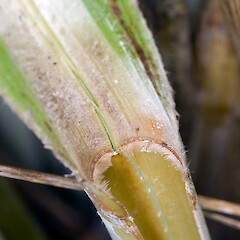Austroderia toetoe
Common name
toetoe
Synonyms
Cortaderia toetoe Zotov
Family
Poaceae
Flora category
Vascular – Native
Endemic taxon
Yes
Endemic genus
Yes
Endemic family
No
Structural class
Grasses
NVS code
The National Vegetation Survey (NVS) Databank is a physical archive and electronic databank containing records of over 94,000 vegetation survey plots - including data from over 19,000 permanent plots. NVS maintains a standard set of species code abbreviations that correspond to standard scientific plant names from the Ngä Tipu o Aotearoa - New Zealand Plants database.
AUSTOE
Chromosome number
2n = 90
Current conservation status
The conservation status of all known New Zealand vascular plant taxa at the rank of species and below were reassessed in 2017 using the New Zealand Threat Classification System (NZTCS) – more information about this can be found on the NZTCS website. This report includes a statistical summary and brief notes on changes since 2012 and replaces all previous NZTCS lists for vascular plants.
Please note, threat classifications are often suggested by authors when publications fall between NZTCS assessment periods – an interim threat classification status has not been assessed by the NZTCS panel.
- Conservation status of New Zealand indigenous vascular plants, 2017 . 2018. Peter J. de Lange, Jeremy R. Rolfe, John W. Barkla, Shannel P. Courtney, Paul D. Champion, Leon R. Perrie, Sarah M. Beadel, Kerry A. Ford, Ilse Breitwieser, Ines Schönberger, Rowan Hindmarsh-Walls, Peter B. Heenan and Kate Ladley. Department of Conservation. Source: NZTCS and licensed by DOC for reuse under the Creative Commons Attribution 4.0 International licence.
2017 | Not Threatened
Previous conservation statuses
2012 | Not Threatened
2009 | Not Threatened
2004 | Not Threatened
Distribution
Endemic. Confined to the North Island where it grows from about Carters Beach (western Waikato) south to Wellington. There are reports of it from the Waitakere Ranges that require further investigation. It has been planted and has sparingly naturalised on Waiheke Island. Not naturally occurring in the Tongariro-Taupo region on the Volcanic Plateau, but has naturalised from plantings e.g. on the Pihanga Saddle.
Habitat
Common in freshwater swamps and wet places from sea level to lower montane habitats. Often growing in association with flax/harakeke (Phormium tenax).
Wetland plant indicator status rating
Information derived from the revised national wetland plant list prepared to assist councils in delineating and monitoring wetlands (Clarkson et al., 2021 Manaaki Whenua – Landcare Research Contract Report LC3975 for Hawke’s Bay Regional Council). The national plant list categorises plants by the extent to which they are found in wetlands and not ‘drylands’. The indicator status ratings are OBL (obligate wetland), FACW (facultative wetland), FAC (facultative), FACU (facultative upland), and UPL (obligate upland). If you have suggestions for the Wetland Indicator Status Rating, please contact: [Enable JavaScript to view protected content]
FACW: Facultative Wetland
Usually is a hydrophyte but occasionally found in uplands (non-wetlands).
Detailed description
Stout, tussock-forming grass up to 4 m tall when in flower. Leaf-sheath glabrous, ivory with green midrib, copiously covered in white wax. Ligule 4 mm. Collar dark brown, upper surface clothed in short hairs. Leaf-blade 2(–3) m × 3 cm, straw-yellow, light-green, rarely dark-green, undersides long hairy toward margins, upper surface with a thick weft of hairs at base, otherwise minutely hairy through, and rather harsh due to numerous prickle-teeth. Culm up to 4 m, inflorescence portion up to 1 m tall, stiff, erect, densely plumose. Spikelets numerous, 25 mm with 2–3 florets per spikelet. Glumes equal, 25 mm, > florets. Lemma 10 mm, 3-nerved, scabrid. Palea 6.5 mm, keels ciliate. Callus hairs 1.5 mm. Rachilla 0.5 mm. Flowers either perfect or female. Anthers of perfect flowers 4.8 mm, in females 2.8 mm. Ovary of perfect flowers 1 mm, stigma-styles 1.8 mm; female flowers with ovary 1.3 mm, stigma-style 3.5 mm. Seed 2.5–3 mm.
Manaaki Whenua Online Interactive Key
Similar taxa
Easily identified by the stout, erect, densely plumose inflorescences, and ivory leaf sheaths. Their spring or summer flowering, waxy leaf sheaths, and the dead leaves which fold longitudinally and disarticulate in their entirety separate Austroderia species from South American pampas grasses (Cortaderia species), which flower in autumn, dead leaves curl up toward the leaf base, ultimately decaying to a state resembling wood shavings. Pampas grasses can always be distinguished by their brittle leaves with a prominent midrib—fold a leaf across and it snaps or can be torn easily. Austroderia leaves have multiple ribs and cannot be torn across easily.
Flowering
November–February
Fruiting
October–March
Life cycle
Florets are wind dispersed (Thorsen et al., 2009).
Propagation technique
Easily grown from fresh seed (as a revegation exercise ripe seed heads can be pinned to soil surface, and if kept damp, soon germinate) and division of established plants.
Threats
Abundant and not threatened. Often naturalising in suitable habitats.
Where To Buy
Uncommon in cultivation and generally too robust for urban gardens. Occasionally offered by specialist native plant nurseries.
Attribution
Fact sheet prepared for NZPCN by P.J. de Lange 1 October 2003. Description adapted from Edgar & Connor (2000).
References and further reading
Edgar E, Connor HE. 2000. Flora of New Zealand. Vol. V. Grasses. Christchurch, Manaaki Whenua Press. 650 p.
Thorsen MJ, Dickinson KJM, Seddon PJ. 2009. Seed dispersal systems in the New Zealand flora. Perspectives in Plant Ecology, Evolution and Systematics 11: 285–309.
NZPCN Fact Sheet citation
Please cite as: de Lange, P.J. (Year at time of access): Austroderia toetoe Fact Sheet (content continuously updated). New Zealand Plant Conservation Network. https://www.nzpcn.org.nz/flora/species/austroderia-toetoe/ (Date website was queried)





